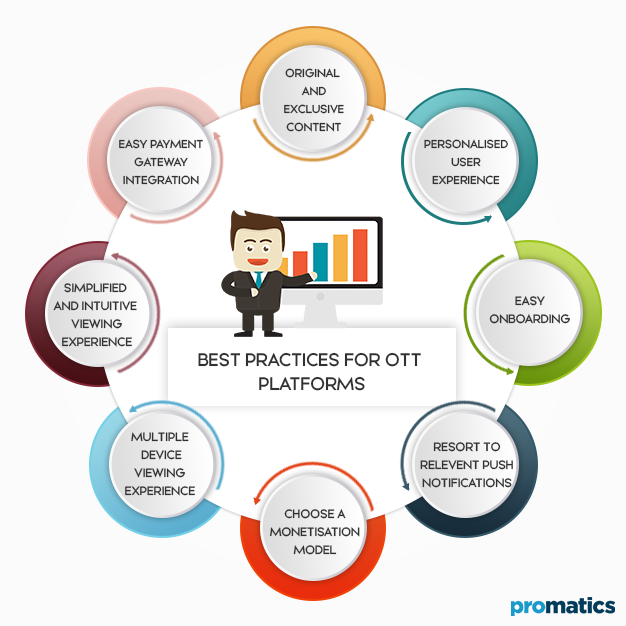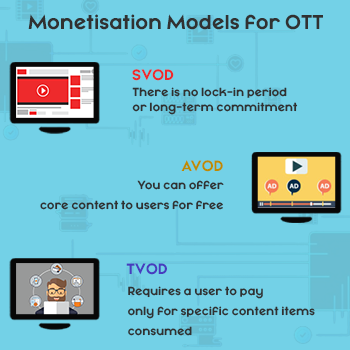What to Consider When Building an OTT app like Netflix
A brilliant amalgam of the virtues of television and digital videos, OTT apps are a rage today. The acronym ‘OTT’ stands short for the phrase Over-The-Top. OTT service allows a user to stream content online without any sign up for a cable or satellite TV service.
A report from Limelight Networks claims that Indians spent an average of 8 hrs 28 min each week watching online videos in 2018. This is much higher than the global average. High viewership makes India an inviting investment environment for global players. Netflix and Amazon entered the Indian markets simultaneously and conquered it. All popular Indian TV channels from Sony to Star have an app today. Local digital players are scaling up their model of business. They are graduating from being cable channels to direct-to-consumer streaming avenues. The OTT market is set to welcome new innovations because of the sheer value of the market that India offers.
Best Practices
Here is a concise list of best practices that we observe when we work on an OTT app:
I. Original & Exclusive Content
Original content is an asset for OTT apps. It is the difference-maker that helps the app with user retention. Keeping the content exclusive to an app creates a monopoly. Businesses find manufacturing exclusive content for a singular platform to be expensive. But, it is worth it if you do it right. Developing deep insights into consumer behaviour is a huge plus for content creation. It helps the business to understand what is binge-worthy for an app user. Invite exclusive attention from the audience with original content. A huge plus of exclusive content is that it keeps licence costs in check. Netflix’s original series like Scared Games and Ghoul built a huge fan following. The geographical scale of the OTT app also counts when it comes to the success of original content.
II. Personalised User Experience
Modern digital experiences served to audiences come personalised to a degree. Personalisation is the secret sauce to building a user’s favourite digital streaming app. A new OTT app on the market is expected to follow suit. A great way to create an indulgent UX is by using AI technology. AI can work excellence into the recommendation engine of the OTT app making it intuitive. Machine learning algorithms of AI can help OTT users discover content that they like. A farsighted app records user behaviour patterns from all devices used to access the app. This helps the business configure the right personalised mix for a user. An intuitive recommendation engine like that of Netflix ensures high content consumption rate.
III. Easy Onboarding
Easy on-boarding is the stepping stone to a successful UX. An indulgent OTT mobile app would be one that puts a simplified onboarding process in place. Developers need to keep the formalities to the minimal. For example, the app must ask for only essential personal details and permissions. Additionally, app designers need to keep the versatility of prospective users in mind. It is important to educate a user about how the prospective uses of the product. At the same time, a tech-savvy user might not want to be preached. Tutorials for the on-boarding need to be optional. Giving a user the option to skip a tutorial guided onboarding can streamline it. Also, allow users to experience the app interface & content before asking them to sign up.
A good example of excellent onboarding in OTT app is Hotstar app. The app lets users view popular content and membership benefits first. The option to sign up for a free trial/ membership follows afterwards. All in all, easy on-boarding translates into increased logins.
IV. Resort to Relevant Push Notifications
Massive clutter in the world of digital content drives a user into confusion. A rational consumer is quick to grab a better offer when it springs in the market. Businesses need to nourish meaningful customer relationships to inspire loyalty towards a brand. Sharing relevant micro-targeted messaging like push notification is a winning strategy for OTT. If targeted, push notification campaigns can increase engagement many folds. This ensures better retention, more conversion, and more ROI. Push Notifications from an OTT app can driver new subscriptions. But, if overdone push notifications can also lead to users abandoning the app.
V. Choose a Monetisation Model
A business without profits is charity. Lack of a proper monetisation strategy at the heart of the app development is the reason why apps fail. It is in the interest of the business to choose a monetisation model early on. Here are some monetisation options to consider for OTT businesses:
- Subscription Video on Demand (SVOD)
This model requires users to pay a fixed monthly fee for access to an unlimited library of content. Users prefer this option because there is no lock-in period or long-term commitment.
- Ad-Supported Video on Demand
With advertiser collaborations, you can offer core content to users for free. Ad-Supported Video on Demand (AVOD) fares well for generic content.
- Transactional Video on Demand
Transactional Video on Demand (TVOD) requires a user to pay only for specific content items consumed. TVOD has wider outreach. Users are not bound by monthly subscription.
VI. Multiple Device Viewing Experience
Content consumers today are privileged to have multiple devices. Consequently, they intend to consume OTT content on multiple devices. While big screen LEDs create a more immersive viewing experience, tablets and mobiles are interactive and portable. Creating a multiple device viewing experience for OTT users is a necessity today. Different devices also require different versions—Smooth Streaming, HLS, HDS, MPEG-dash, and even Flash. Developers need to ensure that the app maintains the right video aspect ratio for each screen.
VII. Simplified and Intuitive Viewing Experience
An OTT app built with user convenience at its heart will be up for the win. A simplified and intuitive viewing experience is a key to getting users hooked to your app. You need to integrate features into the OTT that make it a quality viewing experience. Little things like resume option can ease user experience with the app. Users need to be able to choose if they want subtitles with content. Further, it’s best if the quality of the video is not compromised when internet speed is slow. To ease such pain points, the app must allow app download and save option for viewing later on.
VIII. Easy Payment gateway integration
Payment is a crucial step in the customer journey from a business perspective. Developers need to integrate seamless payment gateway to their OTT app. It is best if the payment experience is presented to the user as an extension actual app experience. Make the gateway compatible with cash cards, net banking and digital wallets. Also, app makers must ensure protection against frauds and protection of user data. Make it a practice to bill users every month on the same day for consistency in payment cycle. A quick payment settlement cycles ensure the smooth functioning of the app business.
Conclusion
According to a report by Boston Consulting group, Indian OTT market is predicted to reach a market size of $5 billion by 2023. It would not be wrong to label the times as the age of digital revolution. For a business with a broadcasting background, the time is ripe to enter the OTT market to make a fortune. An OTT app that offers exclusive content based on user behaviour pattern will be a user favourite. Users also stick to an app that offers hassle-free onboarding and easy navigation. Use micro-targeted push strategy to nudge users into engagement. The growth potential in OTT space is inviting for greater collaboration of veterans. It is time for investment in richer data and new technologies.
We at Promatics, keep these best practices in mind to enhance the consumer OTT experience.
Still have your concerns?
Your concerns are legit, and we know how to deal with them. Hook us up for a discussion, no strings attached, and we will show how we can add value to your operations!


